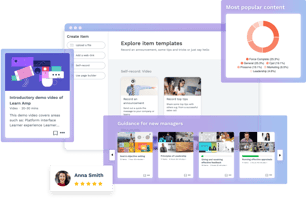Some of the world's most successful companies such as Apple, Google, and Airbnb use 'Design Thinking'. But what is this process, and what does it have to do with learning pathways?
What is a learning pathway?
A learning pathway is an online or blended roadmap of content and activities that a learner works through in their own pace, hosted on a Learning Management System (LMS) / Learning Experience Platform (LXP).
What is the current problem with the creation of learning pathways?
Humans want to be perfectionists.
The thought of releasing a learning pathway to employees that is ‘less than perfect’ can be stressful. Often, the task of curating the perfect content can be so daunting that people are put off from starting the task at all.
The solution to this is applying Design Thinking, and in particular, the concept of MVP.
What is ‘Design Thinking’?
Design Thinking is a process which focuses on producing innovative and creative solutions to the end user's problems.
The main objective is to improve products by understanding how users interact with a LMS. These are the five key steps of Design Thinking:
- Empathise – with the needs and problems faced by your users
- Define – the needs and problems of your users
- Ideate – create new and innovative ideas
- Prototype – start creating solutions
- Test – test out solutions
What is an MVP?
An MVP is a minimum viable product. This is an important part of Design Thinking.
The aim of an MVP is to develop a new product with sufficient features so as to satisfy early users, but waiting to develop advanced features until enough feedback on the basic version has been received.
This means that designers focus on creating a product that is functional and reliable, before anything else.
This is both cost and time effective: by gathering feedback first, no time or money need to be wasted on developing features which aren’t desired.

|
How is this relevant to the creation of Learning Pathways?
By applying the idea of Design Thinking and MVP, we encourage you to avoid worrying about producing the perfect final learning pathway the first time around, and rather just to put out a functional learning pathway on your LXP or LMS which you can then improve after further analysis and feedback.
Applying Design Thinking to content curation
The idea of uploading content for employees can be daunting. How will you know if they will find the content engaging and enjoyable? People can spend too much time trying to curate the perfect content. But, applying the concept of MVP, these are the best steps to take:
- Upload content, even if you feel the selection is not perfect yet.
- Ensure that your LMS/LXP has the following key LMS features: 'Most popular content' and 'Most completed content'.
- After a certain period of time, analyse which LMS features are doing best, and from then on you can make an informed decision about what type of content to keep uploading to your LMS.

|
Applying Design Thinking to quizzes
Setting quizzes is an effective way to measure your employees' knowledge and test their understanding of certain topics. Instead of expending too much energy focusing on curating the perfect quiz, focus on following the MVP philosophy:
- Produce a quiz and set it for your employees.
- Ensure that your LMS/LXP has a function for quiz and score analysis.
- After the quiz has been completed, gather feedback and analyse the scores, to see where it could be improved.
- For example, if there is one question which all learners are answering incorrectly, then you can assume there is something wrong with the question: e.g. it is too difficult, or the wording is poor.
- Finally, make changes to the quiz where necessary.
Conclusion
Ultimately, applying Design Thinking and the idea of MVP can be immeasurably helpful when creating Learning Pathways. Instead of spending too much time and effort on the ‘final product’, it’s always best to get a basic version out of the door, which you can then tweak and change as necessary.




